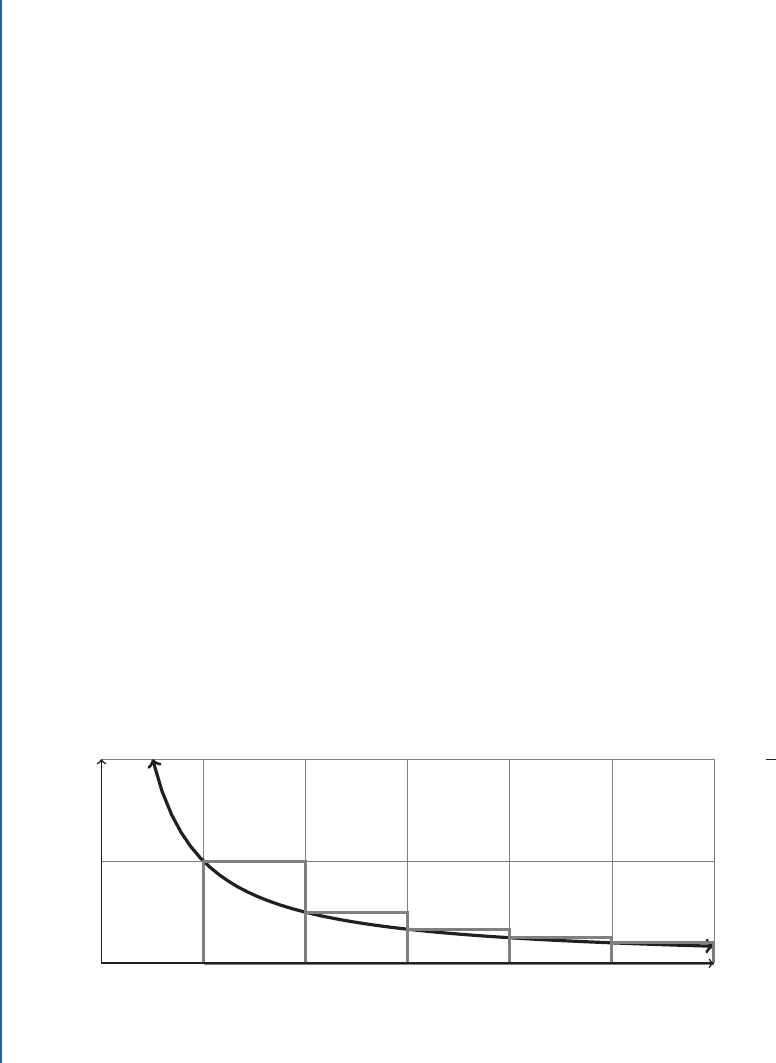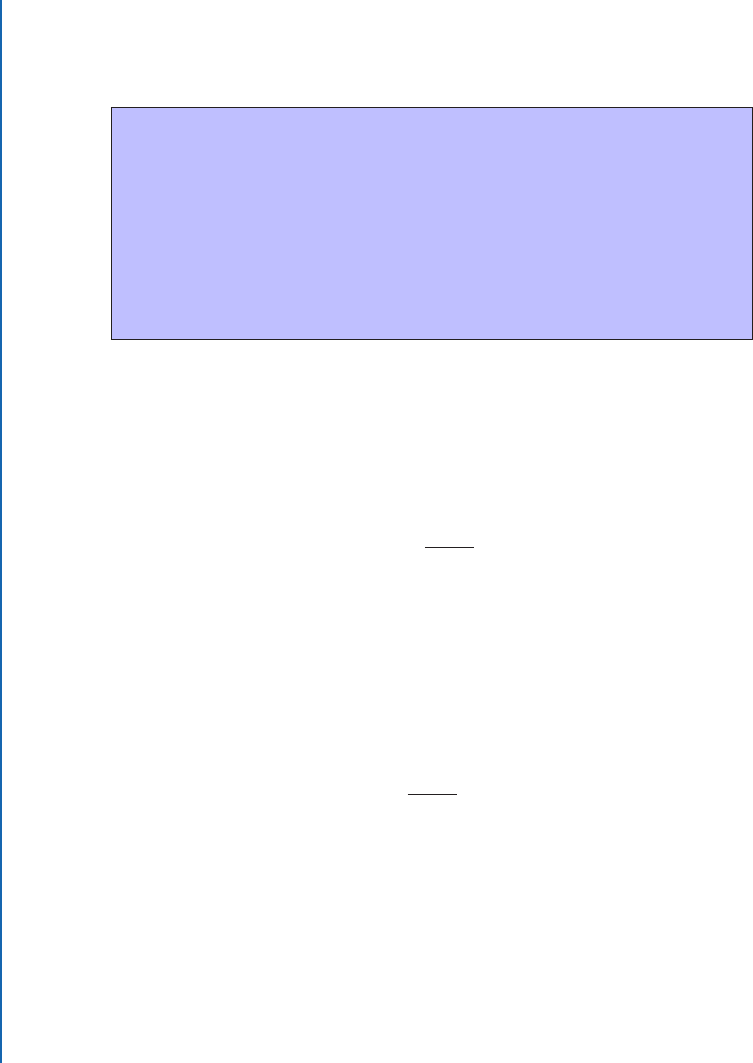
126 4. SEQUENCES, SERIES, AND FUNCTION APPROXIMATION
Problem 4.17 A ball is dropped from a height of 8 m. If each bounce is 3/4 the height of the
one before it, estimate the total vertical distance traveled by the ball.
Problem 4.18 A rod is initially displaced 2.1 mm from equilibrium and undergoes damped
vibration with a decay in the length of each subsequent swing of 0.937. Find the total vertical
distance traveled by the end of the rod.
Problem 4.19 A ball is dropped from a height of 4m. If each bounce is 0.86 times the height
of the one before it, estimate the total vertical distance traveled by the ball.
Problem 4.20 A rod is initially displaced 3cm from equilibrium and undergoes damped vi-
bration with a decay in the length of each subsequent swing of 0.987. Find the total vertical
distance traveled by the end of the rod.
Problem 4.21 A very orderly and goes first north then east over an over. If the distances it
travels before turning go 1, 1/3, 1/9, 1/27, and so on, what the is distance from its starting point
that it approaches as it travels farther and farther?
4.2 SERIES CONVERGENCE TESTS
In this section we will develop a number of tests to determine if a series converges. At present,
we know that an infinite geometric series with a ratio of a with jaj < 1 will converge, but not
much else. We begin with a motivating example.
y D
1
x
6
2
Figure 4.2: Shown is a portion of the graph of y D 1=x and a sequence of rectangles of width 1
and height 1=n for n D 1; 2; 3; : : :.

4.2. SERIES CONVERGENCE TESTS 127
Example 4.22 Determine if the series
1
X
nD1
1
n
has a finite or infinite sum.
Solution:
Examine Figure 4.2. is shows that a series of rectangles with area 1; 1=2; 1=3; : : : have
a larger area than
Z
1
1
dx
x
because the area under the curve is strictly smaller than the sum of
the areas of the rectangles. Computing the integral:
Z
1
1
dx
x
D lim
a!1
Z
a
1
dx
x
D lim
a!1
ln.x/
ˇ
ˇ
ˇ
ˇ
a
1
D lim
a!1
ln.a/ ln.1/
D 1
shows us that:
1
X
nD1
1
n
1; and we conclude the sum is infinite.
˙
e series
1
X
nD1
1
n
is sufficiently important that it has its own name: the harmonic series.
Definition 4.7 When considering
1
X
nD1
x
n
we call x
n
the general term of the series.
Example 4.22 is another example of proving something about a series sum by drawing a clever
picture. An interesting technique, but, as before, we need more general tools. One such tool
involves taking the limit of the sequence generating the series. If it does not approach zero,

128 4. SEQUENCES, SERIES, AND FUNCTION APPROXIMATION
there is no hope that the infinite sum converges.
Knowledge Box 4.8
e divergence test
If lim
n!1
x
n
¤ 0 then
1
X
nD0
x
n
does not have a finite value.
It is important to note that the divergence test is uni-directional. If the general term of a series
does go to zero, that tells you exactly nothing about the behavior of the sum of the series.
Example 4.23 Show that
1
X
nD0
n
n C1
diverges (has an infinite sum).
Solution:
Since
lim
n!1
n
n C1
D 1;
the series in question diverges by the divergence test. Colloquially, we are adding up an infinite
number of terms that are approaching one – so the resulting sum is infinite.
˙
When you can use it, the divergence test is often short and sweet. e next test is the formal
version of the test we used in Example 4.22.

4.2. SERIES CONVERGENCE TESTS 129
Knowledge Box 4.9
e integral test
Suppose that f .x/ is a positive, decreasing function on Π0; 1/ and that
x
n
D f .n/. en,
1
X
nD1
x
n
and
Z
1
a
f .x/dx
both converge or both diverge for any finite a 1.
Example 4.24 Show that
1
X
nD1
1
n
2
is finite.
Solution:
Use the integral test.
Z
1
1
dx
x
2
D lim
a!1
Z
a
1
dx
x
2
D lim
a!1
1
x
ˇ
ˇ
ˇ
ˇ
a
1
D lim
a!1
1
a
.1/
D 0 C 1 D 1
Since the improper integral is finite, so is the sum. Note that this does not tell us the value of the
sum.
˙
e fact that the series
1
X
nD1
1
n
diverges but
1
X
nD1
1
n
2
converges motivates our next test.

130 4. SEQUENCES, SERIES, AND FUNCTION APPROXIMATION
Definition 4.8 A p-series is a series of the form
1
X
nD1
1
n
p
where p is a constant.
Knowledge Box 4.10
e p-series test
e p-series
1
X
nD1
1
n
p
converges if p > 1 and diverges if p 1.
e series convergence test in Knowledge Box 4.10 follows directly from the integral test –
something you are asked to verify in the homework.
Example 4.25 Determine if
1
X
nD1
1
n
converges to a finite number or diverges.
Solution:
is series has the form of a p-series with p D . Since > 1, we conclude the series
converges.
˙
Example 4.26 Determine if
1
X
n
D
1
1
p
n
converges to a finite number or diverges.
..................Content has been hidden....................
You can't read the all page of ebook, please click here login for view all page.
